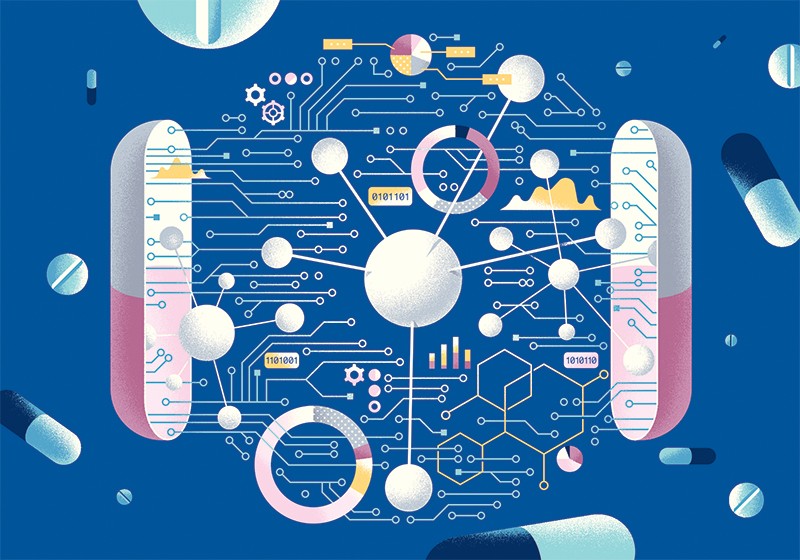GNS has raised a total of $38 million over the years—
這些年來,GNS共籌集了3800萬美元——
from Amgen Ventures, the venture capital arm of the drug giant, along with Celgene and a variety of other investors—
資金來自制藥巨頭的風險投資機構(gòu)Amgen Ventures以及賽爾基因和各種各樣的投資者——
to build and fine-tune its models of disease. And in a recent series of trials, first published in 2017 in the medical journal The Lancet,
建立并調(diào)整其疾病模型。并且近期的一系列試驗于2017年首次發(fā)表于醫(yī)學期刊《柳葉刀》,
GNS has detailed REFS's potential when applied to a disease such as Parkinson's—
在試驗中,GNS詳細說明了REFS應用于一種疾病,如帕金森氏綜合癥時的潛能,
an ailment in which pleiotropic factors render existing treatments wildly hit-or-miss in their effectiveness.
在治療這種疾病時,多效性因素致使現(xiàn)有治療方法的效果參差不齊。
With Parkinson's, the network of interactions set in motion by defective genes has a particular shape to it,
對于帕金森氏綜合癥,有缺陷基因調(diào)動的交互網(wǎng)絡(luò)具有特定的形狀,
and the breakdown of motor functioning is the most reliable indication of its progression.
并且運動機能的中斷是其進展中最可靠的指示。
Feeding the genetic data of Parkinson's sufferers and a control group into REFS
將帕金森氏綜合癥患者的基因數(shù)據(jù)和一個對照組的基因數(shù)據(jù)輸入REFS中
helped GNS generate over 100 computer models depicting what might be going on as motor function deteriorates.
可以幫助GNS生成了100多個計算機模型,用以描繪運動機能惡化時可能發(fā)生的情況。
The models can uncover previously unknown genetic mutations that may contribute to the speedup of deterioration.
這些模型可以揭露之前未知的基因突變,這些突變可能導致疾病惡化的加速。
But that's just the first part. GNS has used those findings to create 5,000 different computer simulations of randomized control trials,
但這僅僅是第一部分。GNS利用這些發(fā)現(xiàn)創(chuàng)造了5000個隨機對照試驗的不同計算機模擬
each aiming to predict how fast the disease would progress with varying approaches to treatment.
每一個的目的都是預測,在不同治療方式下,這種疾病的進展速度會有多快。
Such speed--testing can be vastly more economical than seeking the same result through controlled human trials.
這樣的速度測試比通過控制人體試驗尋求同樣的結(jié)果要經(jīng)濟得多。

And GNS, in partnership with other drugmakers, is now applying similar approaches to treatments for diabetes,
并且GNS正在和其他制藥公司合作,將類似的治療方法應用于糖尿病、
ALS, multiple myeloma, and breast cancer, among other diseases.
肌萎縮側(cè)所硬化癥、多發(fā)性骨髓瘤和乳腺癌等疾病。
"We now have the ability to create and construct, on the computer, representations of human patients and their diseases
“現(xiàn)在我們有能力在電腦上創(chuàng)建人類患者以及他們所患疾病的表現(xiàn),
such that we can now probe, drug by drug, care management intervention by care management intervention,
這樣一來,我們就可以對每一種藥物以及每一種護理管理干預進行探究,
and say what treatments work for which patient," says Colin Hill, CEO of GNS.
并得知哪一種治療方法對哪種病人是有效的,”GNS的CEO Colin Hill說到。
The simulation, in other words, is not just finding correlations: It is answering What if questions.
換句話說,這種模擬并不僅僅是尋找關(guān)聯(lián)性:它是在回答‘假使將會怎么樣’的問題。
What if we had given drug A instead of drug B to patient X?
如果我們給病人X服用藥物A而不是藥物B會怎么樣?
That ability to simulate and answer counterfactuals is a recent arrival in the practice of A.I.
在AI實踐中,這種模擬和回答反設(shè)事實的能力是最近才出現(xiàn)的。
It owes its growing importance in large part to GNS's technology adviser,
其日益增長的重要性很大程度上要歸功于GNS的技術(shù)顧問,
Judea Pearl, a longtime A.I. researcher and professor of computer science at UCLA.
Judea Pearl,AI研究人員,兼UCLA計算機科學部教授。
In a popular volume published last year called The Book of Why,
在去年出版的暢銷書《The Book of Why》中,
Pearl describes how true intelligence ascends from merely noticing patterns, which machine learning does in spades,
Pearl描述了真正的智能是如何從僅注意機器學習的模式
to being able to express counterfactual reasoning about what would have happened, based on those patterns.
提升到能夠根據(jù)這些模式,對可能要發(fā)生的事情進行反事實推理的。
Data alone, disconnected from any idea of a mechanism, doesn't provide real insight.
僅憑數(shù)據(jù),不與任何機制的想法相聯(lián)系,就無法提供真正的洞察力。
"Data is profoundly dumb about causality," claims Pearl. Hill puts it more bluntly: "Deep learning is not that deep."
“數(shù)據(jù)對因果關(guān)系是極其愚蠢的,”Pearl聲稱。Hill則說得更直接:“深度學習沒那么深奧。”
Daniel Cohen, now 67, spent his childhood in Tunisia's heterogeneous society of Jews, Christians, Muslims,
丹尼爾·科恩現(xiàn)年67歲,他的童年是在突尼斯猶太人、基督教徒以及穆斯林組成的混雜社會中度過,
"living all together in a very elegant and pacific way."
“他們以一種非常優(yōu)雅而平和的方式生活在一起。”
He credits that experience for his taste for "things that are not complicated, but complex."
他將這一段經(jīng)歷歸功于自己對“并不難懂卻很復雜事情”的喜好”。
When he was 9, Cohen's family immigrated to Paris, where he pursued the piano avidly.
9歲時,科恩的家人移民到了巴黎,在那里他對鋼琴有著強烈的追求。
He switched to medicine once he realized he might have a greater impact as a scientist than a musician, but the passion has not left him.
當他意識到作為一名科學家可能比音樂家更有影響力時,他轉(zhuǎn)向了醫(yī)學,但激情并沒有離去。
He has been a guest conductor at the Royal Philharmonic in London and dreams of leading that ensemble in Tchaikovsky's Symphony Pathetique.
他是倫敦皇家愛樂樂團的客座指揮,并夢想著在柴可夫斯基的《悲愴交響曲》演奏中帶領(lǐng)著這個樂團。
"The predisposition to orchestra conductor, CEO, and scientist are all controlled by the same genes," he jokes.
他開玩笑說到,“對交響樂指揮、CEO和科學家的傾向都是由同一種基因所控制的。”
譯文由可可原創(chuàng),僅供學習交流使用,未經(jīng)許可請勿轉(zhuǎn)載。












